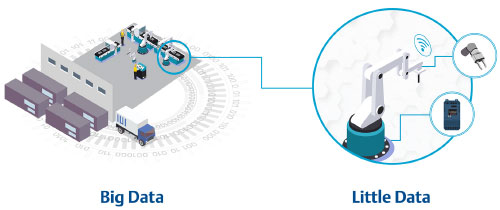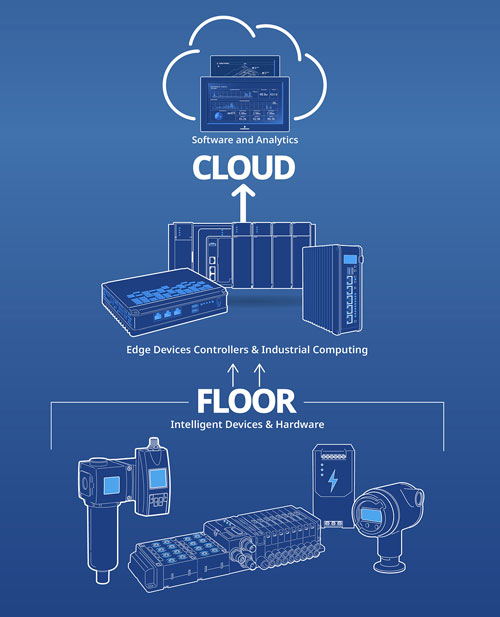- By Silvia Gonzalez
- August 30, 2023
- Features
Summary
The digital transformation journey for each company is unique, yet there are common guidelines to help ensure successful implementations.

- Optimize efficiency.
- Ensure quality.
- Minimize downtime.
- Improve sustainability.
- Support problem solving.
- Increase safety.
These gains become possible when new and legacy systems are outfitted with technologies for establishing a seamless and transparent “shop floor to the cloud” architecture. Smart instrumentation, digital controllers, and other Industrial Internet of Things (IIoT) field devices need to integrate smoothly with higher-level systems.
Determining how and where to begin is a challenge, and some large initiatives have failed to deliver value. This article discusses why the most effective projects start small with defined business cases and a clear roadmap, and then build momentum and can be scaled up as they deliver quantifiable results.
Digital transformation is a journey
Digital transformation is not any one technology and is never achieved after just one project. Instead, it is an evolution and an iterative process of identifying and solving problems. Each step forward often reveals less consequential issues, which themselves become targets to address.
An organization’s culture, markets, and risk tolerance play a role in how digital transformation is executed. Industrial manufacturing operations typically are looking for simple and reliable ways to access edge-located operational technology (OT) “little data,” and transport it to higher level information technology (IT), and even cloud-based resources for “big data” analysis, which can lead to data-driven actions (Figure 1).

1. What problem is being solved?
Identifying the root cause of pain points is a common approach. Where is production constrained by pinch points, and how can energy usage and emissions be reduced? What ways can quality be improved so waste is decreased, and how can equipment be kept running longer without unexpected outages? Can the enterprise supply chain be better coordinated, and what other deficiencies exist? Better data is usually the key to answering questions like these.
2. Who is affected?
It is important to engage stakeholders, so they see the benefit of problem solving. Both internal (engineering, maintenance, operations, sales) and external (end customers, distributors) stakeholders have needs, sometimes conflicting, but often overlapping. The right data will prove the case for essential stakeholders.
3. Why does the problem need to be solved?
The ability to clearly identify the problem, along with the benefits of resolving it in a definable and timely manner, increases the chance of success. Larger problems should be broken down into bite-sized evolutionary pieces so small successes can be achieved early, then scaled up into larger wins.
4. Is the problem worth solving?
By defining the value of success and the cost of doing nothing, the team can make or break the case for any given digital transformation effort. Sometimes there are initial infrastructure costs for networking or computing assets, but these can be appropriately spread across several projects, so each particular project carries a fair share.
5. What information do we need to solve the problem?
Getting the right data is obviously foundational to the preceding questions. Sometimes it is already available and just needs additional analysis, but often, better data is needed. The automation maturity level of an organization impacts the amount of effort required to connect with source data.
Automation maturity and accessing stranded data
An organization’s automation maturity level can be assessed in three dimensions: people, technology, and data. To understand how a digital transformation project will proceed, the following questions should be considered:
- Are personnel comfortable with technology and resulting data, and can they best be classified as implementors or users?
- Where is the company on the spectrum of technology adoption and implementation?
- Is data currently siloed, or are there already systems in place to provide wider accessibility?

- Manual operations: Data is collected by hand and trapped on paper or in isolated databases.
- Islands of automation: Control systems collect some time-series process data, but they may not be connected to higher-level systems.
- Connected automation: Control systems data is aggregated by historians or other higher-level computing assets, with some level of interconnectedness.
- Enhanced connectivity and analysis: Data is widely available for analysis, and other non-process information, such as equipment diagnostics, is also collected and stored.
- Insight-driven operations: Data is collected throughout the organization, from the shop floor up to cloud-based enterprise systems, with advanced analytics software in place, leading to actionable insights and forecasts.
Organizations lower on the scale of automation maturity have greater quantities of stranded essential data that is isolated, ignored, under-sampled, outright inaccessible, or non-digitalized. Digital transformation projects must be structured to overcome these shortcomings.
Start small, but plan for scalability
A digital transformation team should use the preceding considerations as they plan their first projects. Before diving too deep into details, a high-level roadmap should be created to define milestones that guide the activity.
To do this, the team will need to obtain and manually analyze any existing data from a wide range of digital and even paper sources. This is necessary to gain understanding of the issues at hand, even though the intent is not to solve them completely. At this proof-of-concept stage, the team is defining a project scope, costs, and benefits.
With a contained scope in hand, the team can internally “sell” the project by soliciting buy-in from stakeholders, identifying implementation personnel, and communicating the plan to business units. This communication is critical because digital transformation projects are about empowering users to perform their jobs more easily and effectively by leveraging technology and data.
Build on a successful platform
So far, we have looked more at project planning concepts, and less at underlying technologies because there are plenty of challenges for implementers to first address at the conceptual level before diving into the nuts and bolts of building a project. Even as a digital transformation project proceeds, its team generally prefers to focus on solving business problems, as opposed to expending effort on implementation details.
For this reason, digital transformation teams are best served by choosing an automation and information hardware/software platform built on recognized and proven industry standards. At all levels, the platform should provide open interoperability and complete flexibility, but it must be equally adept for both OT and IT needs to provide seamless integration from plant floor to enterprise cloud. This includes the ability to interface with legacy systems, in addition to contemporary technologies. And to support the goal of starting small while remaining scalable, platform elements should be easy to install in a localized manner, as well as simple to connect to each other and up to higher-level systems.

- Field devices: sensors, actuators, motor controllers.
- Computing hardware: protocol and network conversion gateways, programmable logic controllers (PLCs)/programmable automation controllers (PACs), edge controllers, operator interfaces, industrial PCs.
- Software: control development environments, human-machine interface (HMI)/supervisory control and data acquisition (SCADA), data servers, analytics for productivity and energy management, edge computing, and connectivity.
- Services: implementation expertise supported by a team of engineers and developers
A comprehensive digital transformation platform includes options for all these needs, designed and tested to work together seamlessly, with appropriate cybersecurity. This last point bears special consideration because digital transformation necessarily implies a higher level of network and Internet connectivity, which in turn produces greater concerns and risk surrounding cybersecurity. Proper cybersecurity cannot be simply added on, and instead must be built in using proven secure-by-design and defense-in-depth measures.
Following a digital transformation roadmap
The digital transformation journey is different for each organization, but there are some common best-practice guidelines that can be followed to improve success. The primary goals are connecting smart technologies to valuable field data, providing visibility, and delivering actionable results through analytics to help users optimize their operations.
By asking the right questions and creating a high-level roadmap supported by answers, digital transformation teams create clarity around goals, costs, and expected value, helping engage appropriate stakeholders and making the right moves. Regardless of the organization’s automation maturity level, it is important for digital transformation teams to start small, win big with a few high-value projects, then scale up their successes leveraging the support of end users.
With high-level roadmaps in hand, project teams are prepared to undertake all types of digital transformation projects. While implementation details are important, it is more critical to maintain a primary focus on the larger digital transformation tasks at hand. For these reasons, implementers are best facilitated by selecting and building their solutions using a comprehensive digital transformation platform—consisting of field devices, computing hardware, control/visualization/edge software, and services—provided by a leader in the industrial automation and computing field. This allows them to focus on people and the business, with time-tested digital tools to support their efforts and improve workflows throughout the organization.
Reader Feedback
We want to hear from you! Please send us your comments and questions about this topic to InTechmagazine@isa.org.


